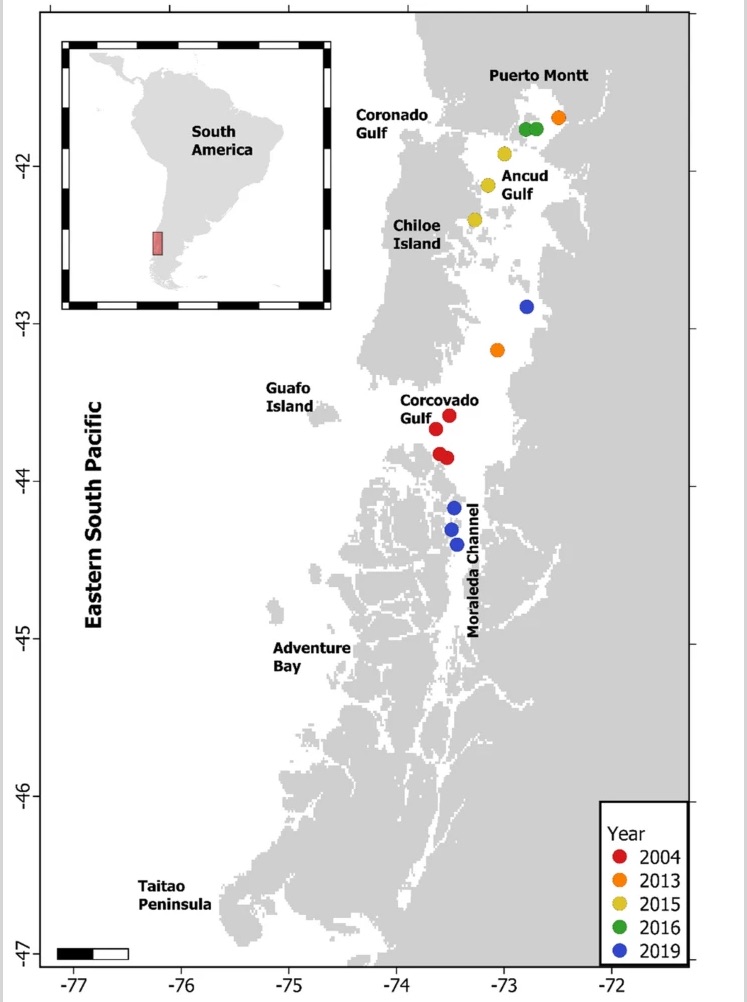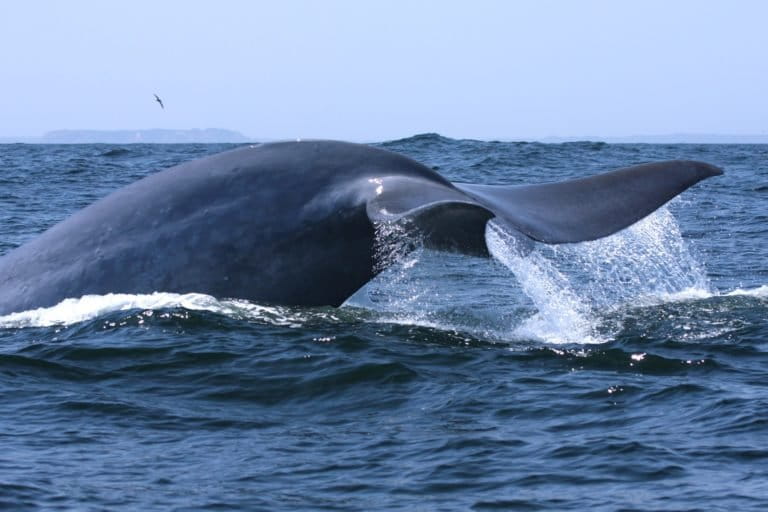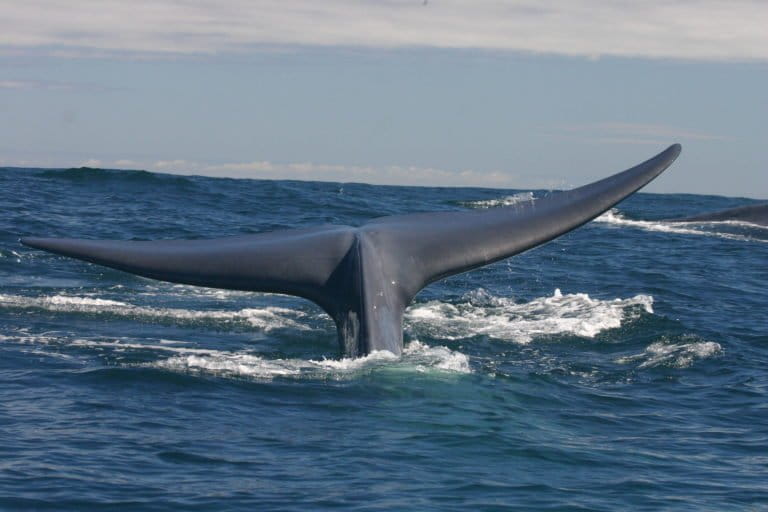- Blue whales feeding off Chile’s north Patagonia coast have to dodge hundreds of vessels daily, most of them serving the area’s salmon farms.
- Marine traffic in the area is so intense that scientists have described it as a “neural network” of connections between salmon farms.
- The various impacts range from collisions, which can result in the death of whales, to noise pollution that prevents the whales from feeding properly.
- The researchers behind the study have called for measures to mitigate the vessel traffic intensity and be more mindful of the whales in the area.
Researchers have for the first time been able to show visually the impacts that marine traffic is having on the world’s biggest animal off the north of Chile’s Patagonia region.
The visualization, widely shared on social media, shows a week in the life of a blue whale (Balaenoptera musculus) as it tries to feed amid the buzzing traffic of hundreds of vessels transiting out to the Pacific Ocean. The video of the lonely blue dot zigzagging between an army of red dots is just one part of a more important finding.

A whale, the blue dot, dodges hundreds of vessels in northern Chilean Patagonia as it tries to feed. Visualization by Luis Bedriñana-Romano/Centro Ballena Azul, Austral University of Chile.
Several years ago, researchers discovered that northern Chilean Patagonia (NCP) is the most important feeding and breeding ground for Southeast Pacific blue whales during the austral summer. Now, a study published in Scientific Reports has identified, within this large space, the four areas where whales prefer to feed in.
For the study, the researchers installed satellite trackers on 14 whales to observe their movements. In parallel, they constructed a map with the routes of vessels using their satellite information.
What they found when they superimposed the movements of whales and ships is that whales feed in spaces that are subject to intense marine traffic. The situation could endanger the recovery of this unique blue whale population, which consists of just a few hundred individuals and is classified as endangered on the IUCN Red List.
A decade of work
Northern Chilean Patagonia is characterized by a fragmented geography of bays, archipelagos, canals and fjords. The sea there is particularly rich in nutrients due to sub-Antarctic waters mixing with an abundant influx of freshwater from rivers, heavy rains, and glacial melt.

The richness of the Patagonian sea is such that, according to the study, “various microbasins have been identified, some of which have a particularly high level of primary production — that is, of phytoplankton, the tiny algae that are the basis of the whole oceanic food chain.” Consequently, this place is the most important feeding ground for the Southeast Pacific blue whale.
However, this important ecosystem is also home to the second-largest salmon-farming industry in the world, behind only Norway. There are 1,357 salmon-farming concessions in Chile, distributed among the three southernmost regions, according to 2020 data from the national Undersecretariat for Fisheries and Aquaculture.

In 2004, scientists from Centro Ballena Azul, an organization that focuses on blue whale conservation, began to install satellite tracking systems on whales to find out where they migrate to. The aim was to identify areas to propose for protection to allow the population to recover from the hunting of the 19th and 20th centuries, which almost drove the blue whales in this region to extinction.
That year, the scientists tagged four whales in the Gulf of Corcovado. But it took another nine years before they could raise enough funds to continue installing more satellite transmitters. Each of these cost $4,000, according to marine biologist Rodrigo Hucke, president of Centro Ballena Azul and co-author of the study. In 2013, they tagged another two whales in the Sea of Chiloé. In 2015, they tagged three more, in 2016 another two, and in 2019 another four, for a total of 15 whales to date.
While all the tagged whales probably belong to the Southeast Pacific population, the most abundant in the area, the scientists say it’s possible some of the animals may be Antarctic blue whales (B. m. intermedia), a population whose vocalizations have also been recorded in the region. The scientists say there are no visible differences between the two groups, but they can be distinguished genetically.

Video by Nicolás Muñoz/Centro Ballena Azul, Austral University of Chile.
Since 2013, the researchers have discovered “wonderful things” thanks to the satellite transmitters, Hucke said. These include a link between Patagonia and the Galápagos. During the austral spring and summer, Southeast Pacific blue whales feed in Patagonia, but come winter, most of them migrate. Scientists have observed that while some go west, toward the open waters of the Pacific, others go north to the Galápagos. What they do there is still a mystery, but scientists speculate they might breed there.
According to Luis Bedriñana, the lead author of the study, the satellite information collected from transmitters was combined with data gathered on marine expeditions where they counted the whales. “All this information was integrated in a model to finally obtain a map which indicates where the animals are most likely to be found,” he said.
The researchers then superimposed another map on top of this, showing the routes of ships in the region. The data for this are freely available; since 2019, the National Fisheries and Aquaculture Service (Sernapesca) has kept a daily record of navigational data produced by satellite tracking systems on industrial fishing boats, small-scale fishing boats, aquaculture vessels, and transport ships. The aim of combining both maps was to “really see what the biggest animal in the world has to deal with,” Hucke said.
Huge aquaculture fleet
The researchers were able to confirm that, of these four sectors, aquaculture has the biggest presence in the sea. According to the study, the number of active vessels per day was between 602 and 729 for aquaculture, followed by small-scale fishing at 37 to 76 active vessels per day. Transport ships ranged between six and 57, and industrial fishing vessels ranged from one to 13 daily.
The study said that while all boats are very likely to come into contact with a whale in this area, “it is possible that the aquaculture fleet represents the main driver of negative interactions between boats and whales.”

Hucke said the data don’t distinguish between types of aquaculture, but “salmon farming is undoubtedly the biggest industry in the region.” It’s also an industry that has been widely criticized by scientists and conservationists due to the impacts it has on marine ecosystems.
The vessels used by the industry — for transporting salmon from the offshore cages to the onshore processing plants, as well as ferrying feed, supplies and staff — follow a hub-and-spoke route that creates a “neural network between the [salmon] farms,” Bedriñana said.
The map of the whales’ movements indicates they feed mainly in four places: the Gulf of Ancud, the west coast of Chiloé Island, the north of Moraleda Channel, and Adventure Bay. That makes these areas a conservation priority.

But in the first three places, the whales have to deal with the presence of a large number of aquaculture vessels, as shown in the map below. In the case of Adventure Bay, the whales have to dodge mainly industrial fishing boats.

In these areas, the study observed, “urgent management is needed,” due to the different impacts that vessels could be having on the whales, ranging from collisions to noise pollution.
What are the impacts of marine traffic?
“There is evidence that various vessels have crashed into blue whales and killed them,” Hucke said, adding, however, that it’s difficult to estimate the number of accidents resulting from collisions. Not all accidents are reported; whales that die from collisions can often get lost out at sea, or sink, or only die several days later.
“Ninety-nine percent of cases go unrecorded,” Hucke said. “On rare occasions boats have arrived at port not knowing why they are not able to go at normal speed, only to find that they have a whale on the bow.”
He added that “sometimes [boats] hit something, don’t realize and the animal very likely dies. In short, if [the whale] doesn’t make it to shore, it isn’t recorded.”

While there have been ample studies on collisions between whales and boats in the northern Pacific and Atlantic, there has been very little research on the subject in the waters around South America. Off the California coast, one of the best-studied whale habitats, studies indicate that “the growth rate of whales should be much greater than it is currently,” oceanographer Susannah Buchan from Chile’s University of Concepción told Mongabay Latam. One of the causes, she said, “is that many more whales are dying from collisions each year than those which are recorded.”
The worrying thing about this, Hucke said, is that according to Bedriñana’s calculations, if just one of these whales off northern Patagonia dies every two years from human factors, the population will have problems recovering. “And if it’s a female, that’s even worse,” he added.
A second, no less serious impact is the noise pollution caused by marine traffic.
A recently published study on the man-made “cacophony” in the world’s oceans says “sound is the sensory cue that travels farthest through the ocean and is used by marine animals, ranging from invertebrates to great whales, to interpret and explore the marine environment and to interact within and among species.”

The noise made by vessels can interfere with these cues, which interrupts “traveling, foraging, socializing, communicating, resting, and other behaviors in marine mammals,” according to the study.
Buchan said boats make sounds at the same frequencies as whale vocalizations, which has the effect of “masking” the cues emitted by these animals.
Bedriñana these disruptions to the whales’ movements and feeding behaviors could have an impact on the conservation of the species.
“You have to understand that these animals aren’t here on holiday,” he said. “Their mission is to consume large quantities of energy in order to migrate to the Galápagos.”
He added that lack of food in Antarctic waters during some years gives an idea of what could happen to Patagonia’s blue whales if they don’t get enough to eat.
“It has been observed that females may choose not to migrate, not to reproduce that year because they were not able to get enough energy,” Bedriñana said. “If we apply this to our area of study, but instead of low productivity, which can also happen every few years, we look at noise and the inconvenience of having to dodge boats all day, this is energetically demanding, not only in itself, but in that it prevents the animal from feeding.”

This can lead to the whale not getting the energy it needs to make the journey to its breeding ground, and “this has a direct impact on the vulnerable population,” Bedriñana said.
Aquaculture projects don’t consider such impacts in their baselines, although this could change. “The Undersecretariat for Fisheries is finalizing a project through the Fisheries and Aquaculture Research Fund [FIPA], which will finally incorporate marine mammals into baseline studies,” Hucke said. “We have been trying to do something about this for years. Unfortunately, we are very behind. Science is very behind the development of the industry.”
The need for action
Addressing the intense marine traffic associated with aquaculture “is not going to be simple,” Hucke said.
“There are practices that have been effective in the Panama Canal, one of the busiest places on Earth in terms of marine traffic, and there have been other exercises in Costa Rica,” he said.
The first thing that needs to be done, according to the study, is to prioritize the four areas identified as being most important to the whales for feeding.
“For now, the most effective way of reducing the risk of collision is keeping whales and boats separate, either in space or time,” Hucke said. The study also suggests implementing measures like speed limits.

“Nobody wants to stop anyone from navigating. That’s not what this is about. Rather, it’s about navigating well,” Hucke said, adding this will require “establishing routes, reducing speeds, taking more care in certain areas, diverting certain established routes so that they don’t overlap with the most important places for the whales and, if there are whales, leaving the area.”
He also called for measures to be established according to the time of day, because “it’s at night that whales are closer to the surface because their food is also closer to the surface, and when they’re feeding, they’re oblivious to whatever else is going on around them. All they want to do is eat.”
Although variations in marine traffic throughout the day were not considered in this study, it’s something that scientists hope to look at soon.
“We wanted to focus first on spatial variation and different sectors, in addition to the whale models,” Bedriñana said, but “without a doubt, our next step is to evaluate this. Temporal variation not only between day and night, but seasons too,” he said, adding they also intend to apply this research model to dolphins.
For now, the researchers say they hope these important findings will promote, in Hucke’s words, “a joint effort between scientists and decision-makers including the Navy, the Undersecretariat for Fisheries, Sernapesca and the Minister for the Environment, and that this will lead to a discussion about what options are available so we can pursue them.”
Citations:
Bedriñana-Romano, L., Hucke-Gaete, R., Viddi, F. A., Johnson, D., Zerbini, A. N., Morales, J., … Palacios, D. M. (2021). Defining priority areas for blue whale conservation and investigating overlap with vessel traffic in Chilean Patagonia, using a fast-fitting movement model. Scientific Reports, 11(1). doi:10.1038/s41598-021-82220-5
Duarte, C. M., Chapuis, L., Chapuis, S. P., Costa, D. P., Devassy, R. P., Eguiluz, V. M., … Juanes, F. (2021). The soundscape of the Anthropocene ocean. Science, 371(6529), eaba4658. doi:10.1126/science.aba4658
Banner image: Implanting a satellite transmitter on a blue whale off the Chilean coast. Image by: Rodrigo Hucke-Gaete/Centro Ballena Azul, Austral University of Chile.
This article was first reported by Mongabay’s Latam team and published here on our Latam site on Feb. 15, 2021.
